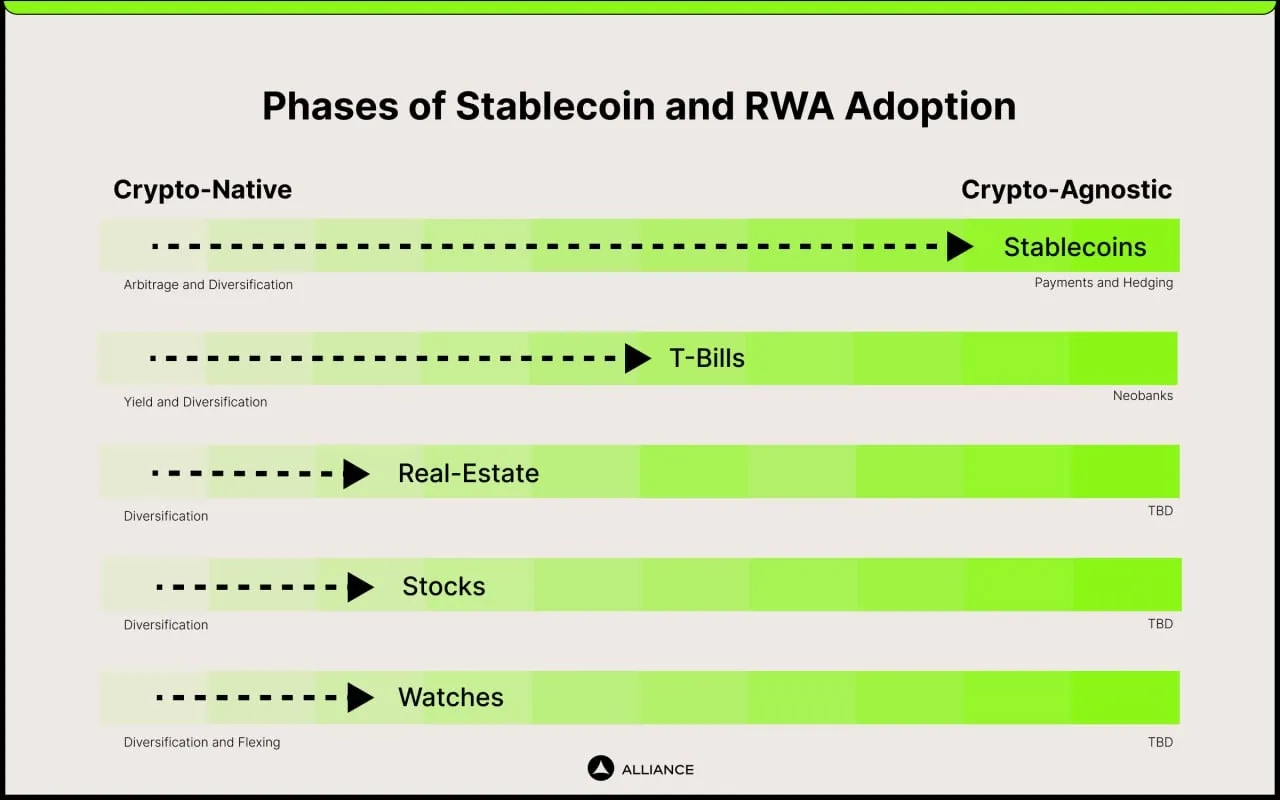Real World Assets, Real World Application

Qiao Wang
·Apr 7, 2024
Coauthored by David Ma and me
It was previously thought that stablecoins and other tokenized real-world assets (RWAs) were the types of crypto applications that would onboard the normies. A decade ago bitcointalk.org talked ad nauseam about remittances. Years ago with the advent of smart contract chains our industry started envisioning Wall Street replacing DTCC with onchain stock settlement.
It turns out that the first wave of stablecoin and RWA adoption never came from normies, or crypto-agnostics. They have to go through crypto-native use cases first.
For example, stablecoins first found product-market-fit through crypto-natives 1) doing cross exchange arbitrage and 2) needing a place to derisk from volatile crypto-assets. Once the stablecoin infrastructure is built and battle-tested, crypto-agnostic use cases can follow on. In that category are payments, remittances, and inflation hedges against quickly inflating currencies like the Turkish Lira, Argentinian Peso, etc. Those use cases were never crypto-native to begin with, but onchain and anecdotal evidence suggests these are growing very quickly in the Global South.
Other RWAs will likely follow the same route. T-bills found their way onchain because crypto-natives wanted the yield on their stables after the Federal Reserve hiked rates from 0% to 5%. Many of these crypto-natives are DAOs like MakerDAO and crypto startups needing to diversify their treasury. Crypto-agnostic use cases are starting to show up here too. Crypto neobanks that enable ex-US countries to save in the USDC/USDT now compete to offer a source of safe US yields to their customers.
This two phase adoption curve — crypto-native then crypto-agnostic — isn’t surprising in hindsight. It’s naturally easier for any crypto product to get adopted first by people who are already comfortable with crypto and have the necessary infrastructure like self-custodial wallets installed.
The question now is, where on this two-phase adoption curve are the various types of RWAs today? And what are the hair-on-fire use cases of these RWAs?
The short answer is:
- Stablecoins are firmly in the crypto-agnostic phase. The most important use cases in this phase are currency hedging and cross-border payment.
- Other RWAs like treasuries, stocks, real estate, and luxury watches are in the crypto-native phase. The most important use case is diversification.

Stablecoins: Hedging and Payment
Stablecoins are settled $10T onchain annually, dwarfing Paypal, on par with Visa, and within an order of magnitude of ACH. Take a moment and let this sink in. This is an astounding achievement with just a few years of development.
What’s equally striking is that the total supply of stablecoins is about $150B. In other words, every dollar turns over 60–70 times onchain annually.
Neither of these stats would have been possible without a borderless and permissionless ledger. One common ideological criticism of stablecoins (and RWAs in general) is that they are not truly crypto-native and therefore uninteresting. But pragmatism flies in the face of ideology. The idea of allowing traditional assets to flow freely on such a borderless and permissionless ledger is something that the market values empirically.
One could reasonably argue that much of this onchain volume is speculative activities, rather than “real-world usage” such as currency hedging and cross-border payments. We will never know what the exact breakdown is between speculation and real-world usage, but even if 1% of the $10T annual volume was indeed used for real-world usage, it would be an astronomical number. Furthermore, our anecdotes are in agreement with the data.
We have personally experienced the magic of onchain payments for years, as we often use USDC to fund startups. We also know that many of our startups use USDC/USDT to pay employees or vendors. But we took a particular interest in this area a year ago when Felipe, AllianceDAO alumnus, told us about the p2p stablecoin market in Colombia, where everyday people meet in real life at shopping malls and exchange physical Peso bills for Tron USDT.
Over the following months, we reviewed 100+ stablecoin-related startups serving users in Latam, Africa, Southeast Asia, and Eastern Europe. The most striking learning is that the majority of them that have a live product have at the very least early signs of product-market-fit (PMF). And by PMF I mean growing 10%+ month over month. Independent of how good the team is.
By contrast, the vast majority of crypto startups outside this vertical don’t have any PMF whatsoever.
The founder of Accrue, an African payment startup we ended up funding, told us about how stablecoins are omnipresent in his family. His sister saved for tuition in stablecoins for close to a year, and it protected her from the 130% devaluation that the Ghanaian Cedi experienced over that period. She then used stablecoin-backed debit cards to pay for her masters tuition in Sweden. His brother regularly moves money from GHS to CAD via stablecoins through Accrue and Kraken. His parents in Ghana regularly send money to their relatives in Nigeria via stablecoins through Accrue’s agent network.
The founder of another African stablecoin startup we funded, GoBankless, recounted a painful story of life and death. A South African hospital refused to admit a patient from Mozambique until payment was settled. But the fiat payment method was unable to settle due it being cross-border (Mozambique and South Africa) and taking place outside of regular banking hours. So the patient and the hospital used stablecoins to settle the payment. This is not a one-off occurrence, because patients in neighboring countries regularly travel to South Africa for medical care due to poor or nonexistent medical infrastructure in their home country.
These are all examples of everyday people using stablecoins to solve hair on fire problems in their lives. This is the crypto-agnostic phase of stablecoin adoption.
Other RWAs: Diversification
Stablecoins are just the first and the most prominent type of RWAs. Other asset classes are coming onchain too.
There’s now $3T, or about 1% of global wealth, stored onchain. Again, this is an astounding statistic. Holders of this wealth can do two things with it. They can leave it as a store of value, or exchange it for something else.
So far in the history of crypto, when they do exchange it, they mostly exchange it for another cryptonative asset, hoping to sell higher or to generate some yield. The problem with these cryptonative assets is that they are highly correlated and highly volatile. As the crypto asset class reaches a mature size against other asset classes, diversification is bound to happen.
Diversification is a simple but a proven need. The world’s largest hedge fund, Bridgewaters, bases their entire philosophy (the All Weather Portfolio) on the idea that combining uncorrelated sources of returns yields greater risk-adjusted returns. The fact that they have grown to the largest AUM in the world of hedge funds is a testament to the investors’ demand for diversification. By the same virtue, the BTC ETF is seeing strong demand because it provides an uncorrelated source of return for TradFi asset allocators.
RWAs are the answer to crypto-natives’ need for diversification, by giving them access to novel sources of uncorrelated and less volatile returns. RWAs are to crypto-natives what the BTC ETF is to TradFi asset allocators.
In 2023, we were stunned that MakerDAO had grown its RWA portfolio from virtually $0 to $4B in less than a year. Today most of it is US treasuries. Recently, Blackrock launched their $100M treasuries tokenization endeavor together with Coinbase. Ondo has $200M in treasuries. Franklin Templeton has a $300M treasuries fund onchain as well. The race is on.
$4B may seem like a relatively small number compared to the $150B stablecoins. But that’s primarily because stablecoins have been around for nearly a decade. On the other hand, treasuries became attractive, by definition, in the post-zero-interest-rate era, which started only 2 years ago. Users need a bit more time to get comfortable with the reliability of new products. Are they tracking indices properly? Do creation and redemption processes work seamlessly? Is there enough liquidity on the secondary market?
After US treasuries, next in line are US equities and US real estate. The legal challenges are real, but once they are solved, there is no fundamental reason why there would not be pent-up demand for tokenized US stocks and US real estate similar to US treasuries. We expect much of the demand for US stocks and real estate to come from abroad. Dinari, a startup we funded that offers tokenized US stocks, is seeing strong demand from China and Russia. The international demand for US stocks and real estate is currently unmet mostly due to capital controls, difficulty in brokerage account creation, and frictions moving money internationally. In China, for example, it’s easier to open a Binance account than to open a US stock brokerage account due to capital controls. In Russia, everyday people are sanctioned by the US from participating in US markets due to the Ukraine war. If US-based assets become freely traded onchain as RWAs, all that an international investor needs to do is find a way to onramp from fiat to crypto. No more financial maze.
A common economic argument against these products is that crypto-native assets and yields offer much better returns. The reality is that these crypto-native assets and yields are too similar. For example, Ethena really is just an ETH beta because the basis widens when ETH goes up. On the other hand, stocks and real estate are all uncorrelated sources of return that the $3T of onchain wealth can tap into.
Once these RWAs’ infrastructure matures, we also suspect that crypto-agnostic use cases will appear. For example, the ability to use equities and real estate as collateral for loans, or the ability for anybody that can get onchain to construct a global portfolio without needing to navigate a legal and banking maze for every asset. But this will be the second phase, the crypto-agnostic phase of RWA adoption.
Conclusion
We’ve been asking ourselves for years what our first non-speculative killer app will be. The mainstream media, TradFi/Web2, and even the crypto community itself don’t realize we actually already have one. It’s crypto-agnostics using stablecoins to hedge against currency debasement and to make cross-border payments. However, because stablecoins don’t fluctuate violently in price and tend to be adopted in emerging markets, they are largely ignored by Twitter discourse.
But stablecoins are only the first type of RWAs. There are early signs of pent-up demand by crypto-natives for tokenized onchain treasuries. The natural next step is to tokenize stocks, real estate, or even luxury watches. These historically uncorrelated and high quality sources of returns can now be accessed by trillions of dollars of onchain wealth yearning for diversification.
Appendix: Alliance Startups in Payment and RWAs
Accrue is building an agent network for fast and affordable cross-border payments within Africa. Any individual or business interacting with the agent network transacts using their local fiat currency while under the hood settlement is over stablecoins. They are cashflow-positive, payment requests are growing more than 20% MoM, and businesses like Opera and Eco are building for Africa on their infrastructure.
Gobankless is another stablecoin-powered payment network in Africa. After only a few months of operations, they are processing over $1M per month. The demand is so strong that they are constrained by working capital.
Lulubit is a crypto neobank for Central America. Among other products and services, they offer stablecoin onramp and offramp, a cross-border payment, and credit card that enable users to pay for real goods and services with crypto. They are growing 30% MoM.
Fractal Payments is a payment solution for businesses, starting with crypto-native ones. Unlike TradFi money movement products, they do not rely on SWIFT and instead leverages stablecoins to facilitate cross-border payments, making transactions cheaper and faster. Their product has already facilitated over $5 million in payment volume, is growing 30% MoM, and is used by leading global businesses like Aragon, Zerion and Orange DAO.
Villcaso: Most previous real estate RWA startups tokenized individual properties, in the form of NFTs, which resulted in illiquidity. Villcaso tokenizes a pool of real estate assets instead. The fungible approach leads to much greater liquidity. Furthermore, the token is legally structured in a way that’s composable with DeFi. In other words, investors can transfer, trade, stake, borrow, and collateralize their holdings seamlessly on existing DeFi rails.
ZwapX: There’s a surprisingly large overlap between luxury watch collectors and crypto investors. By tokenizing watches, ZwapX not only enables faster and safer transactions than traditional OTC markets, but also allows collectors to digitally flex their watches. Just like NFT collectors. They currently have over $1M in TVL.
Dinari: Most previous stocks RWAs were in the form of derivatives. In Dinari, tokens are 1:1 backed with actual shares. Similar to stablecoins and Villcaso, those tokens are composable with DeFi. The founder previously built a unicorn in biotech, an equally regulatorily challenging space as crypto.
Fig: Similar to Ethena, Fig productizes proven hedge funds strategies. Ethena is marketed as a stablecoin, but in reality is a tokenized hedge fund that generates yield from perps. Similarly, Fig generates yield from options, making what was once gated, more accessible.
More to Read
You're Vibe Coding Wrong

Mohamed Elseidy
·Jul 10
Most developers use Tier 1 for UX & rapid prototyping, Tier 2 for daily development, and Tier 3 for complex engineering challenges. The best strategy is to combine them when needed rather than trying to force one tool to do everything. Here's what each tier actually delivers and when you should use them
Your Moat Isn't Your AI Prompt. It's Your Evaluations

Mohamed Elseidy
·Jun 17
Anyone can copy a prompt, but they can't replicate the months of iterative learning, the domain knowledge and the edge cases discovered through real user interactions, and the systematic evaluation framework that guided every prompt tweaking decision.
Shopping is Dead, AI is Taking Over

Mohamed Elseidy
·May 28
Major payment networks are building the infrastructure while AI platforms began to deploy; for startups, this opens opportunities in vertical specialization and merchant tools; and SEO will evolve into AEO as businesses adapt to optimize for AI agents rather than human shoppers.